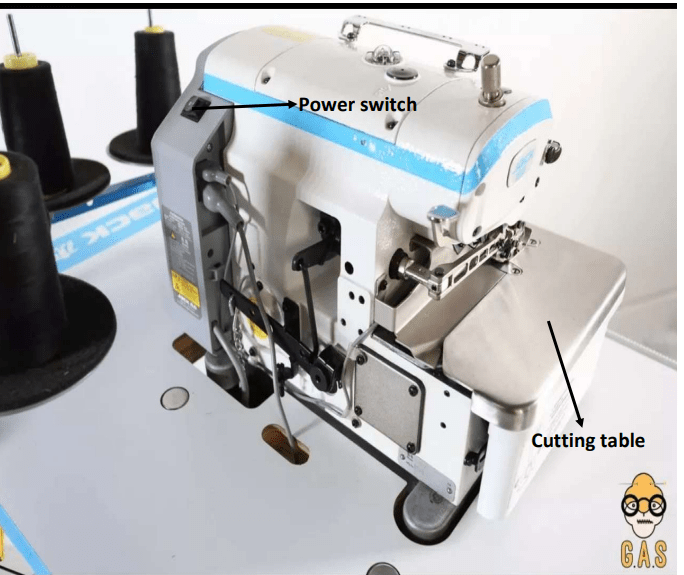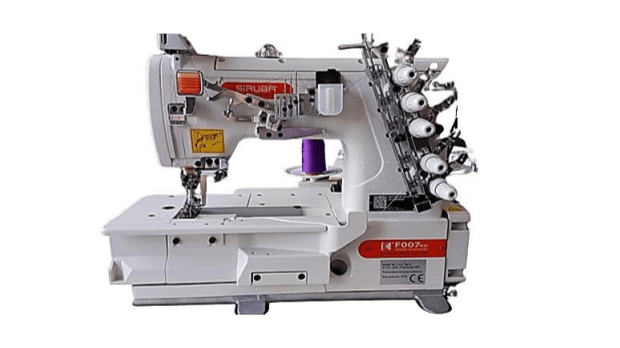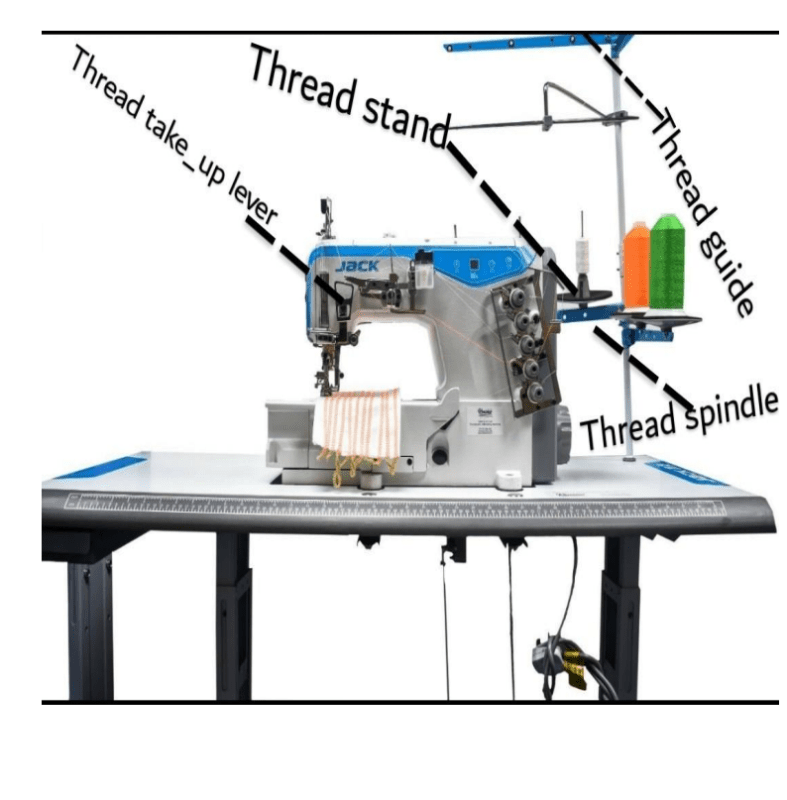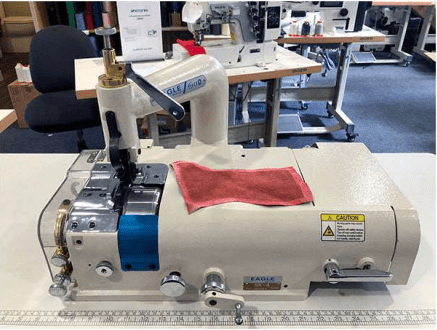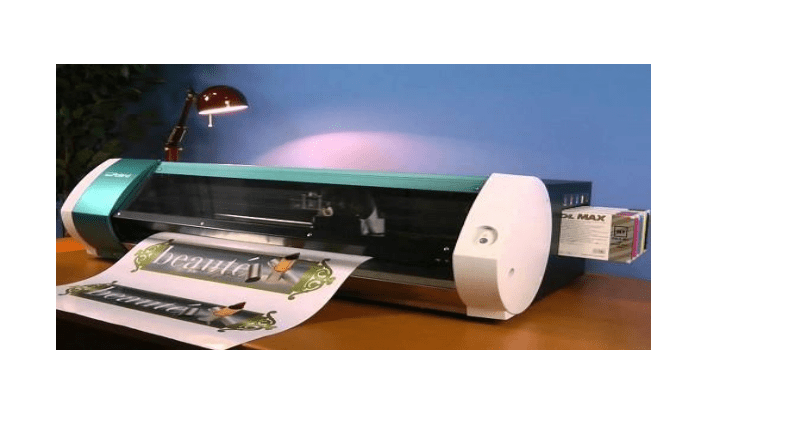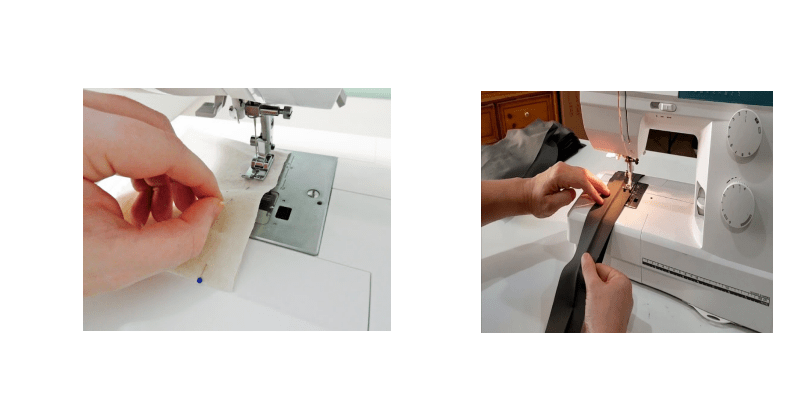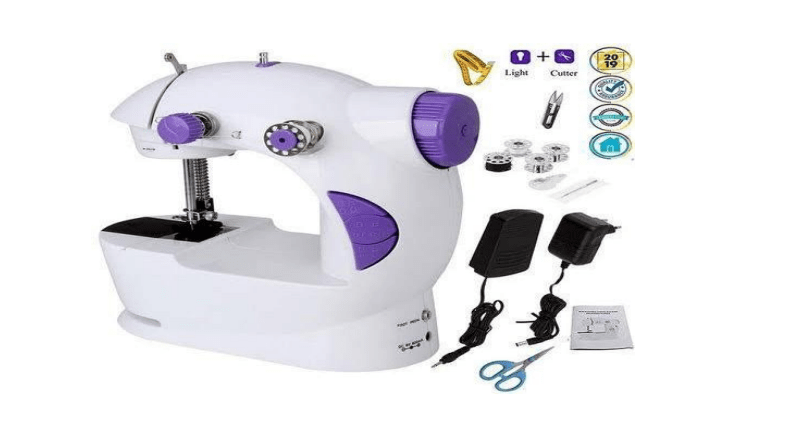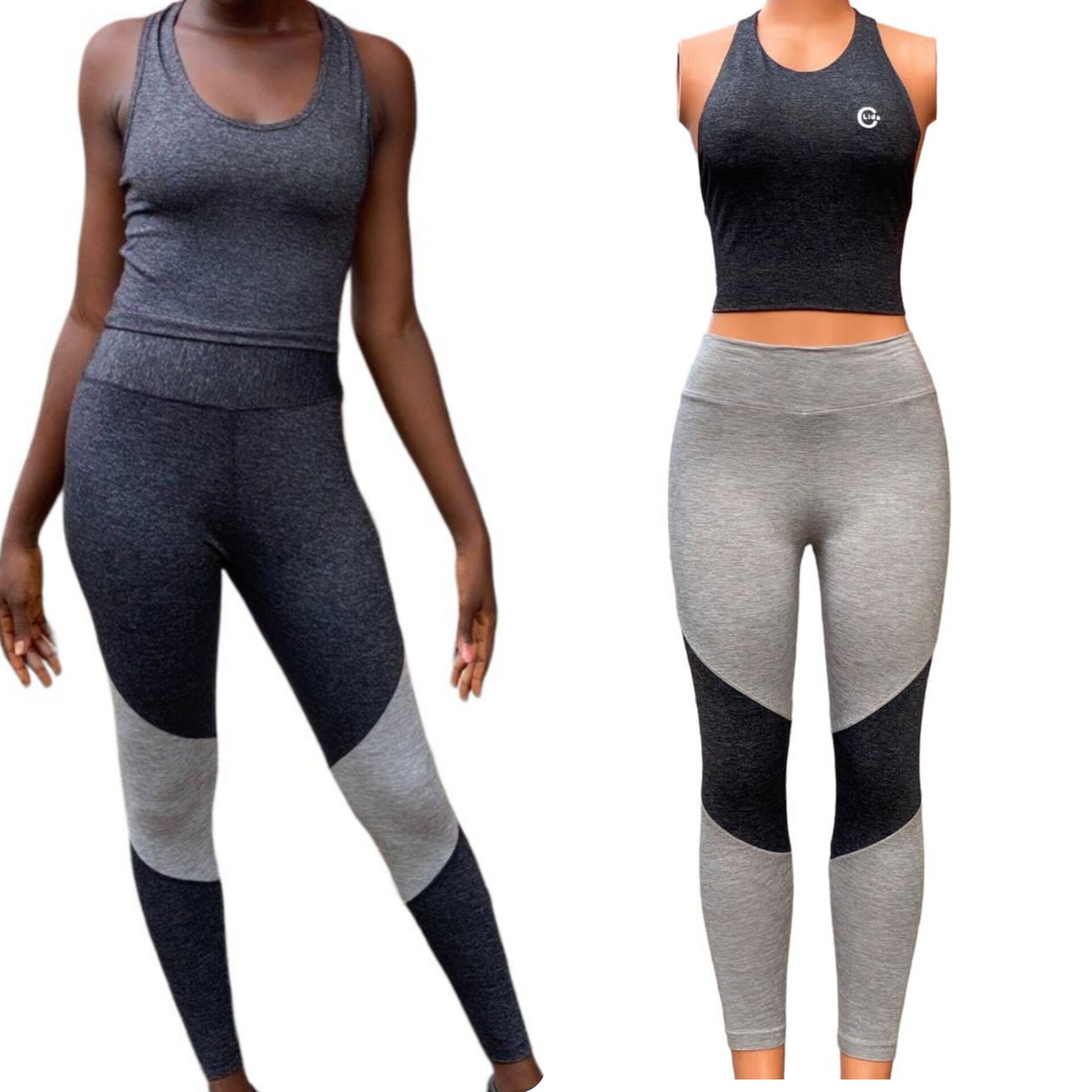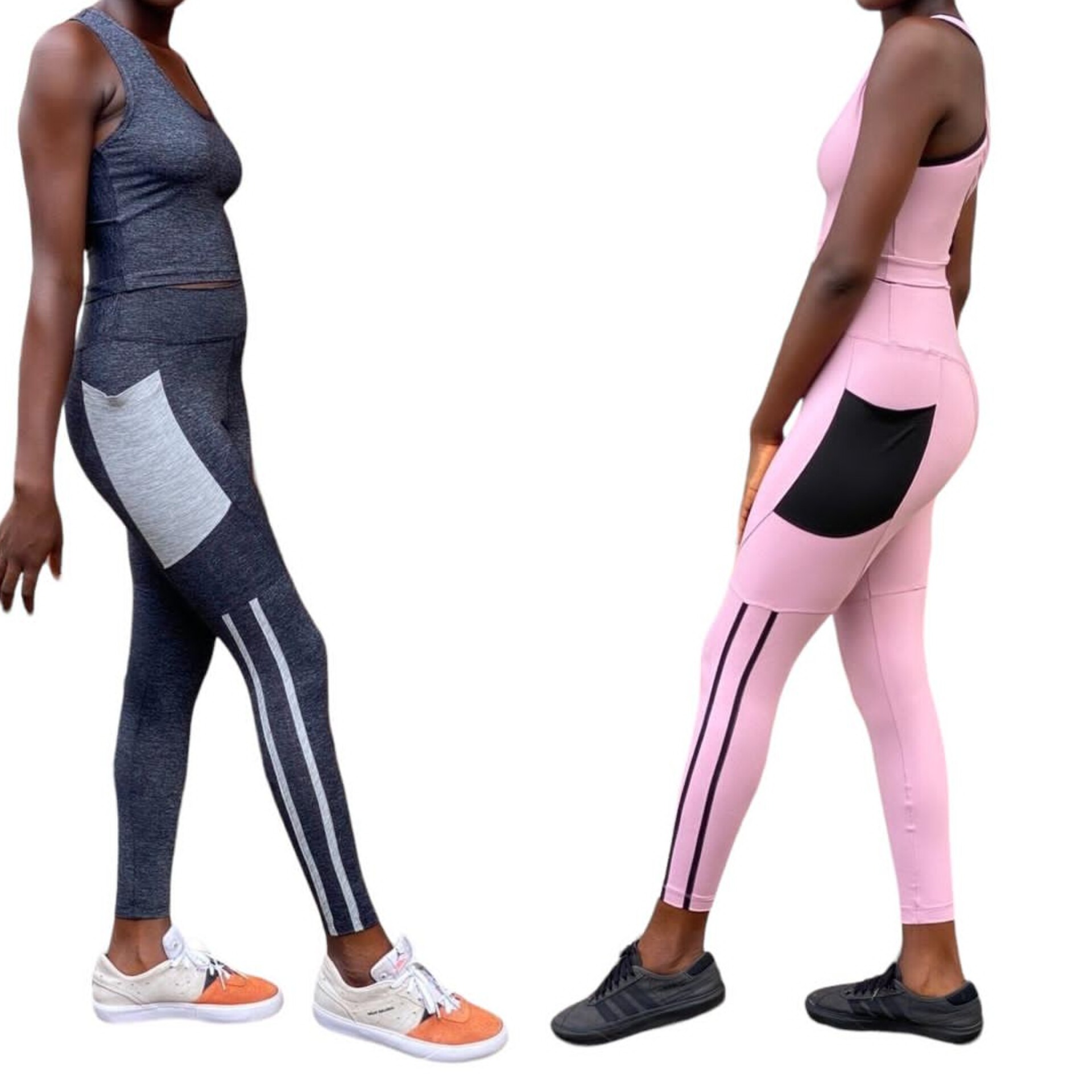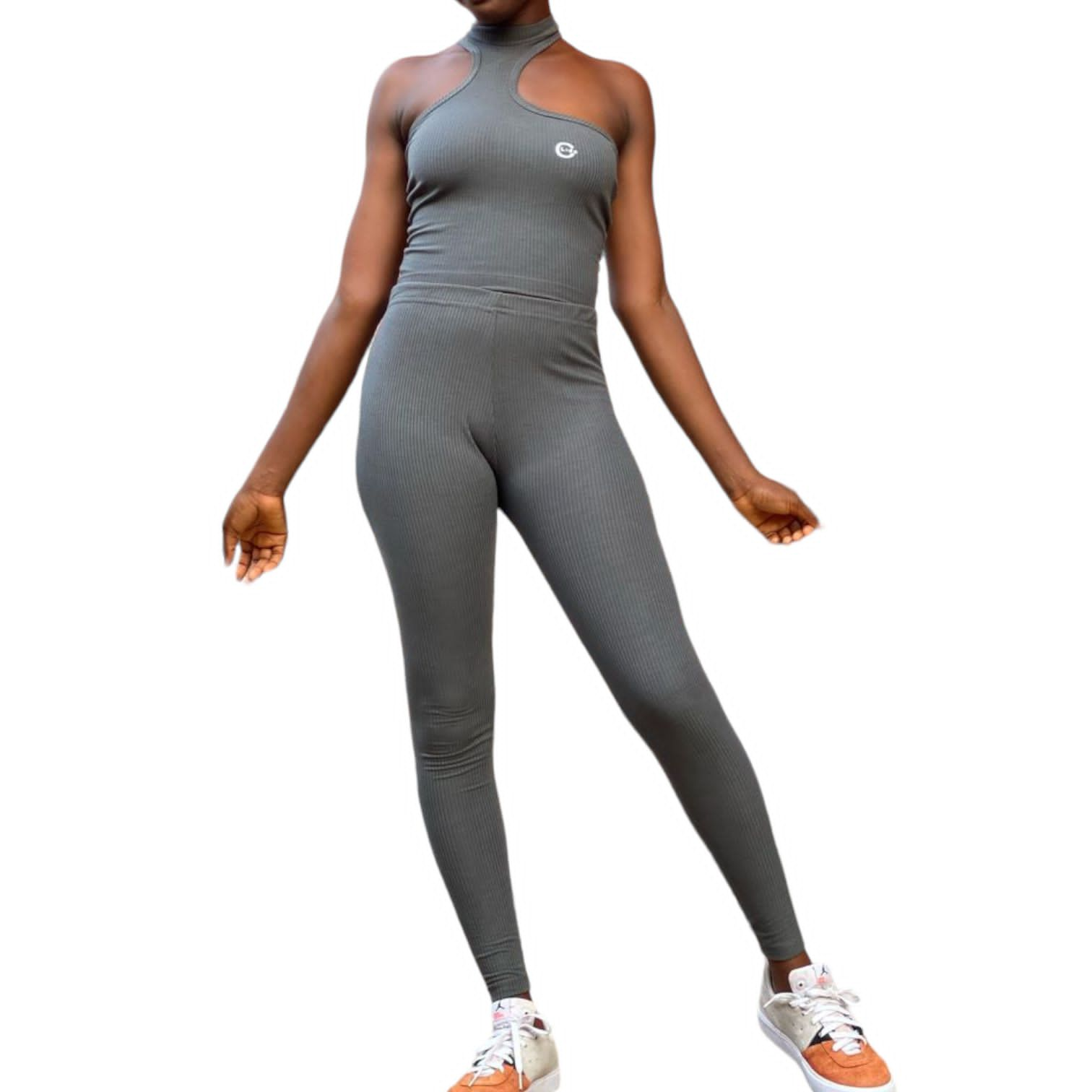20 minute read
introduction
A 5-thread overlocking machine, often known as a
serger, is a sewing machine that uses five threads to stitch
fabric together while simultaneously trimming the edges
and preventing fraying.
This machine combines three overlocking threads
with two straight stitch threads, producing a secure,
professional seam.
The 5-thread overlocking machine is integral in both
industrial and high-quality home sewing settings.
This machine performs multiple functions in a single
pass, making it invaluable for efficiency and quality in
garment construction.
Its primary purpose is to create strong, durable seams and provide a clean finish by trimming excess fabric.
A Well-Detailed Diagram of a 5 thread
Overlocking Machine
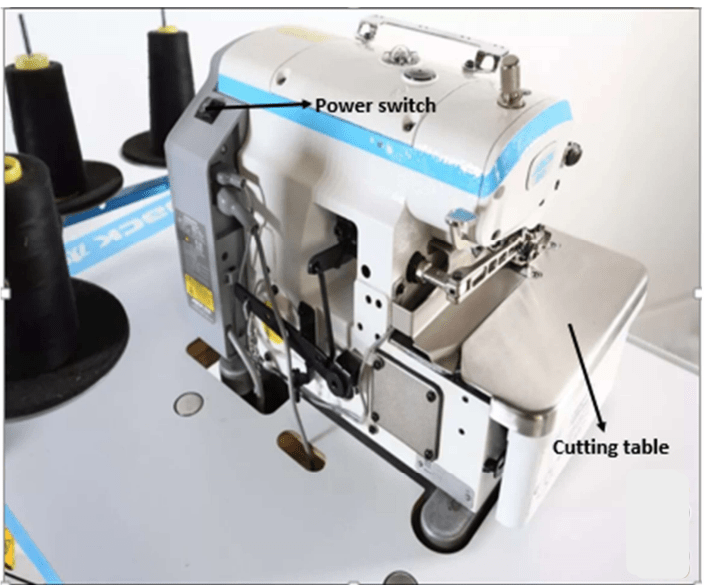
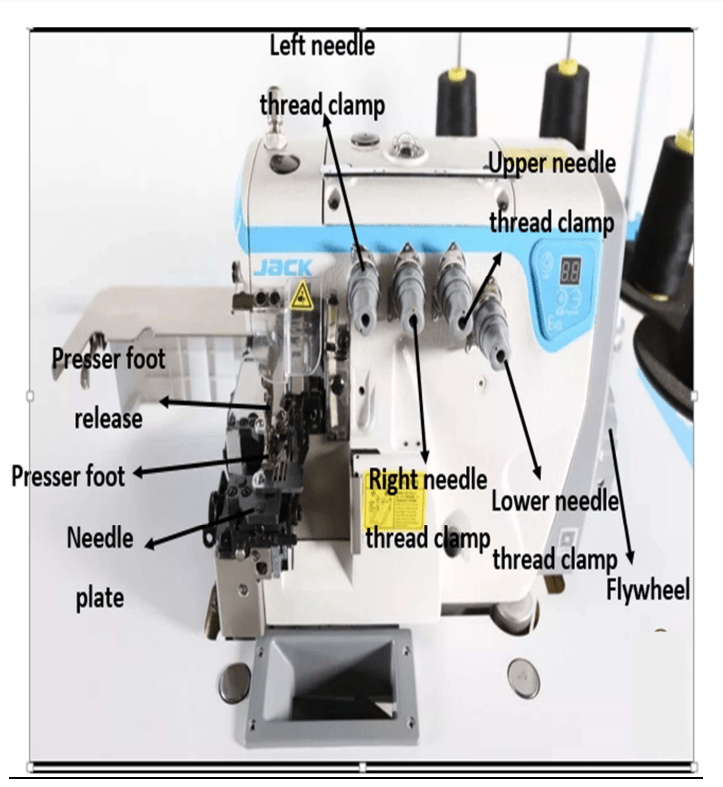
Thread Tension Controls: Thread tension controls are
adjustable dials or knobs that regulate the tightness or
looseness of each thread.
Proper tension ensures even, balanced stitches and
prevents puckering or loose stitches where each thread
has its own tension control for precise adjustments.
Blade: The blade, or cutter, trims excess fabric edges as
the machine sews, providing a clean, neat edge and
preventing fraying.
The blade works simultaneously with the stitching
mechanism to cut fabric just before the threads encase
the edge.
Needle/Presser Foot: The needles pierce the fabric to
create stitches, with 5-thread overlockers typically using
two needles for parallel stitching lines.
The presser foot holds the fabric in place and ensures it
feeds evenly through the machine which allows easy
positioning of fabric.
Scrap Fabric Catcher: The scrap fabric catcher collects
trimmed fabric scraps and thread clippings, keeping the
workspace clean and organized.
It is usually a detachable box or container and this helps
in easy disposal of waste material.
Thread Pole/Guide: The thread pole, or guide, is a vertical
stand that holds the spools of thread, ensuring smooth
and even thread feeding into the machine.
The thread pole helps prevent tangling and maintains
correct thread tension and also ensures smooth
operation.
Thread Holders (Behind): The thread holders are posts or
pegs at the back of the machine where spools of thread
are placed.
They keep the spools in position, allowing threads to be
pulled smoothly into the thread guides and tension
controls which maintains thread consistency.
Feed Dials/Presser Foot Lever: Feed dials adjust the
differential feed mechanism, controlling the fabric’s feed
rate to prevent stretching or puckering.
The presser foot lever raises or lowers the presser foot,
allowing easy fabric placement and removal.
Handwheel/Flywheel: The handwheel is a large wheel on
the side of the machine used to manually raise and lower
the needles and loopers.
It provides precise control over the needle position for
starting, threading, and maintenance tasks which is crucial
for accurate stitching.
A Full Diagram of the 5-thread overlocking
Machine.

Variations of the Machine.
Standard 5-Thread Overlocker:
This is the basic model used for a wide range of sewing
tasks, including seaming, trimming, and finishing edges.
This variation of the 5-thread overlocking machine
provides robust and professional seams suitable for most
fabrics.
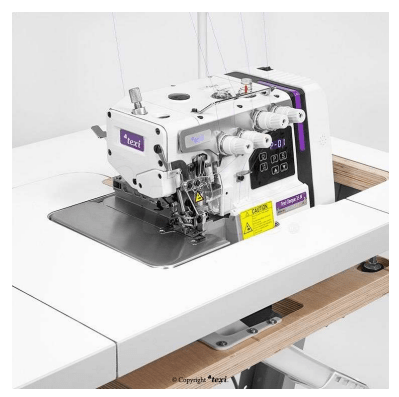
5-Thread Safety Stitch Overlocker:
Designed specifically for creating strong, durable seams
that are crucial in high-stress areas of garments.
This model is often used in the construction of
activewear and workwear, where seam strength is
paramount.
Differential Feed Overlocker:
This variation allows for more precise control over the
fabric feed, which is essential when working with stretchy
or delicate fabrics. The differential feed adjusts the
movement of the feed dogs to prevent fabric stretching
and puckering.
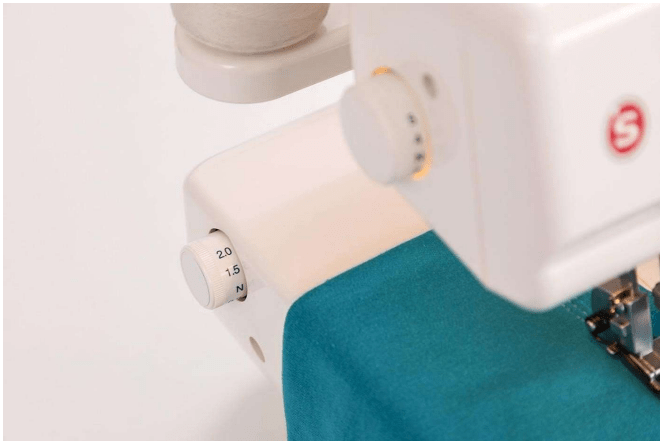
Specific Uses:
- Apparel Construction: Perfect for creating durable
seams in clothing, particularly in knitwear and stretchy
fabrics. - Home Decor: Used for finishing edges on items like
curtains, cushion covers, and table linens. - Quilting: Secures the edges of quilt pieces, ensuring
they don’t fray and stay intact.
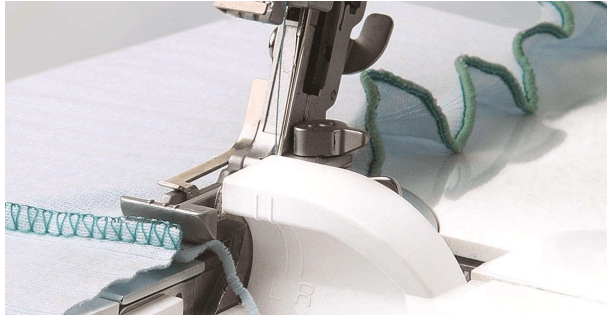
- Crafts: Ideal for crafting projects that require neatly
finished edges and strong seams.
Benefits:
- Efficiency: Combines multiple functions—seaming,
trimming, and finishing—into one operation, saving time
and effort. - Professional Finish: Ensures a neat, clean edge, giving
garments and projects a polished look. - Durability: Produces strong, long-lasting seams that
are suitable for a variety of fabric types. - Versatility: Capable of handling different types of
fabrics, from delicate silks to heavy-duty denim. - Stretch Seams: Especially useful for knit fabrics, as it
allows seams to stretch without breaking.
Maintenance of the Machine
Maintaining a 5-thread overlocking machine is essential to
ensure its longevity and optimal performance. Here are
some key maintenance tasks:
- Regular Cleaning:
- Remove Lint and Dust: Frequently clean the machine
to remove lint and dust, which can accumulate and affect
performance.
Use a small brush or compressed air to clean out the
areas around the needles, loopers, and feed dogs. - Clean the Knife: The built-in knife can accumulate
fabric fibers so ensure it’s clean and sharp to maintain
precise cutting.
- Oiling:
- Lubricate Moving Parts: Regularly oil the moving parts of
the machine as per the manufacturer’s instructions.
Proper lubrication reduces friction and wear, ensuring
smooth operation.
- Needle Replacement:
- Change Needles Regularly: Over time, needles can
become dull or bent, so ensure they are regularly changed
to avoid skipped stitches and fabric damage.
- Threading:
- Correct Threading: Ensure the machine is threaded
correctly according to the user manual because incorrect
threading can lead to tension issues and poor stitch
quality.
- Tension Adjustment:
- Adjust Tension Settings: Regularly check and adjust the
tension settings to ensure even stitching while the whole
sewing process is going on
- Professional Servicing:
- Annual Servicing: Have the machine professionally
serviced at least once a year which involves having a
technician performing a thorough check-up and make
necessary adjustments or repairs.
Safety Precautions to be Taken When Using the
Machine
Using a 5-thread overlocking machine involves certain
safety risks, and it is crucial to follow safety precautions to
prevent accidents:
- Read the Manual:
- Understand Instructions: Thoroughly read and
understand the user manual before using the machine.
Familiarize yourself with all controls and features.
- Proper Lighting:
- Ensure Adequate Lighting: Work in a well-lit area to
clearly see the machine and fabric because this reduces
the risk of accidents and ensures precise sewing.
- Keep Fingers Away:
- Avoid the Needle and Knife: Keep fingers and hands
away from the needle and knife area while the machine is
in operation to avoid injuries.
- Use Safety Guards:
- Employ Guards and Shields: Ensure all safety guards and
shields are in place and properly used. These protect
against accidental contact with moving parts.
- Turn Off When Not in Use:
- Power Off: Always turn off the machine and unplug it
when not in use or when changing needles and threads.
This prevents accidental starts.
- Avoid Loose Clothing:
- Wear Appropriate Clothing: Avoid wearing loose
clothing, jewelry, or accessories that can get caught in the
machine.
- Regular Maintenance:
- Maintain Properly: Regularly maintain the machine to
ensure it operates safely because a poorly maintained
machine is more likely to malfunction and cause
accidents.
- Use the Right Needles and Threads:
- Appropriate Tools: Use the correct type and size of
needles and threads for the fabric you are working with.
This prevents damage to the fabric and machine.
- Keep the Area Clean:
- Organized Workspace: Maintain a clean and organized
workspace to avoid accidents caused by clutter or
misplaced tools.
- Emergency Procedures:
- Know Emergency Stops: Be aware of how to quickly stop
the machine in case of an emergency and always know
where the power switch and emergency stop are located.
Summary:
Fistly, A 5-thread overlocking machine, also known as a
serger, uses five threads to stitch fabric while
simultaneously trimming the edges and preventing
fraying.
It combines three overlocking threads with two straight
stitch threads to produce secure, professional seams,
making it essential in both industrial and high-quality
home sewing settings.
This machine’s primary purpose is to create strong,
durable seams and provide a clean finish by trimming
excess fabric, performing multiple functions in a single
pass for efficiency and quality in garment construction.
Furthermore, Key parts include thread tension controls,
which ensure even, balanced stitches by adjusting thread
tightness, and a blade that trims fabric edges while
sewing.
The needle/presser foot holds and guides fabric,
ensuring even feeding, while the scrap fabric catcher
keeps the workspace clean by collecting waste material.
The thread pole/guide holds spools and ensures smooth
thread feeding, and thread holders maintain thread
consistency.
Feed dials and the presser foot lever adjust the
differential feed and fabric placement, respectively, while
the handwheel allows manual control over needle
position for precise stitching.
Variations of the machine include the standard 5-thread
overlocker for general sewing tasks, the 5-thread safety
stitch overlocker for strong seams in high-stress areas, the
coverstitch machine for hemming and topstitching, and
the differential feed overlocker for precise fabric feed
control.
Specific uses of the machine range from apparel
construction, especially in knitwear and stretchy fabrics,
to home decor, quilting, and crafts.
Maintenance involves regular cleaning to remove lint
and dust, oiling moving parts, needle replacement,
correct threading, tension adjustment, and annual
professional servicing.
Safety precautions include reading the manual,
ensuring proper lighting, keeping fingers away from the
needle and knife, using safety guards, turning off the
machine when not in use, wearing appropriate clothing,
maintaining the machine, using the right needles and
threads, keeping the workspace clean, and knowing
emergency stop procedures.
Multi-choice Questions
Part A
Using the diagram below answer questions 1-8 by naming the components labeled A-J

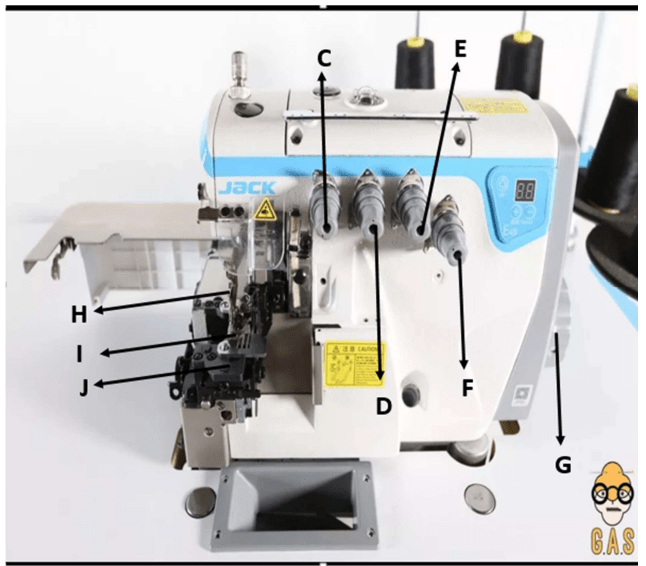
1.The component labeled A is known as _____________ A) Heat Resistant Handle B) Presser Foot C) Cooling Button D) Power Switch
2.The component labeled B is known as ____________
A) Flat board
B) Heating Tube
C) Cutting Table
D) Temperature control Board
3.The component labeled C is known as _____________
A) Left Needle Thread Clamp B) Right Needle Thread Clamp C) Upper Needle Thread Clamp D) Lower Needle Thread Clamp
4.The component labeled D is known as _____________
A) Lower Needle Thread Clamp
B) Left Needle Thread Clamp
C) Upper Needle Thread Clamp
D) Right Needle Thread Clamp
- The component labeled E is known as ______________
A) Left Needle Thread Clamp
B) Upper Needle Thread Clamp
C) Lower Needle Thread Clamp
D) Left Needle Thread Clamp - The component labeled F is known as ____________A) Lower Needle Thread Clamp B) Upper Needle Thread Clamp C) Right Needle Thread Clamp D) Left Needle Thread Clamp
- The component labeled G is known as _____________
A) Flywheel
B) Rotary knob
C) Cooling circle
D) Temperature control - The component labeled H is known as ____________
A) Left Needle Thread Clamp
B) Rubber plate
C) Presser foot release button
D) Presser foot - The component labeled I is known as ___________
A) Presser foot release button
B) Flywheel
C) Cooling button
D) Presser foot - The component labeled J is known as ____________
A) Flywheel
B) Heating Tube
C) Presser foot
D) Needle plate - What is the purpose of the scrap fabric catcher?
A. Holds the spools of thread
B. Collects trimmed fabric scraps
C. Adjusts the differential feed
D. Raises or lowers the presser foot - The _____________part of the machine ensures
smooth and even thread feeding into the machine.
A. Thread tension controls
B. Blade
C. Handwheel
D. Thread pole/guide - What is the function of the feed dials?
E. Adjusting thread tension
F. Controlling fabric feed rate
G. Trimming excess fabric
H. Collecting trimmed fabric scraps - Which variation of the machine is designed for
creating strong seams in high-stress areas of garments?
A. Standard 5-Thread Overlocker
B. 5-Thread Safety Stitch Overlocker
C. Coverstitch Machine
D. Differential Feed Overlocker - What is one specific use of a 5-thread overlocking
machine?
A. Carpet weaving
B. Apparel construction
C. Metalworking
D. Plumbing - Which benefit is NOT associated with using a
5thread overlocking machine?
A. Efficiency
B. Durability
C. Stretch Seams
D. Embroidery capabilities - What is a key maintenance task for the machine?
A. Changing light bulbs
B. Sharpening scissors
C. Regular cleaning
D. Painting the machine - What is the recommended frequency for
professional servicing of the machine?
A. Monthly
B. Bi-annually
C. Annually
D. Every two years - What is the first safety precaution mentioned
when using the machine?
A. Keep fingers away from the needle and knife
B. Read the manual
C. Ensure adequate lighting
D. Turn off the machine when not in use - Why should you avoid loose clothing when
operating the machine?
A. To prevent fabric fraying
B. To ensure even stitching
C. To avoid accidents
D. To maintain proper tension - What should be done before using the machine
for the first time?
A. Clean the machine
B. Lubricate moving parts
C. Adjust tension settings
D. Read the user manual - What is the purpose of using safety guards and
shields?
A. To adjust thread tension
B. To prevent accidents
C. To collect trimmed fabric scraps
D. To lubricate moving parts - What is the consequence of incorrect threading?
A. Stretching fabric
B. Fabric fraying
C. Uneven stitches
D. Fabric shrinking - What should be done to ensure proper lighting?
A. Install additional lamps
B. Work in the dark
C. Use natural sunlight
D. Work in a well-lit area - What part of the machine holds the spools of
thread?
A. Handwheel
B. Thread pole/guide
C. Thread holders (behind)
D. Needle/presser foot - What is the purpose of the differential feed
overlocker variation?
A. Creating decorative stitches
B. Precise control over fabric feed
C. Quilting
D. Adjusting thread tension - Why is regular maintenance important for the
machine?
A. To make the machine louder
B. To ensure proper thread tension
C. To prevent accidents
D. To ensure longevity and optimal performance - What should be done before changing needles
and threads?
A. Turn off the machine
B. Lubricate moving parts
C. Adjust tension settings
D. Increase blade width - What is the purpose of the needle/presser foot?
A. Holds the fabric in place
B. Trims excess fabric edges
C. Collects trimmed fabric scraps
D. Holds the spools of thread - What is the consequence of not maintaining a
clean workspace?
A. Increased efficiency
B. Cluttered environment
C. Decreased risk of accidents
D. Improved thread tension
Part C:
Fill in the gap with the appropriate answers in the blank
spaces given below.
- A 5-thread overlocking machine, often known as
a ___________, is a sewing machine that uses five
threads to stitch fabric together while
simultaneously trimming the edges and
preventing fraying. - The machine combines three overlocking threads
with two ___________stitch threads, producing a
secure, professional seam. - The primary purpose of a 5-thread overlocking
machine is to create strong, durable ___________and
provide a clean finish by trimming excess fabric. - Thread tension controls are adjustable dials or
knobs that regulate the ________or looseness of
each thread. - The blade, or cutter, trims excess fabric edges as
the machine sews, providing a clean, neat edge
and preventing ____________. - The presser foot holds the fabric in place and
ensures it feeds evenly through the machine,
while the presser foot lever allows easy __________
of fabric. - The scrap fabric catcher collects trimmed fabric
scraps and thread clippings, keeping the
workspace clean and __________. - The thread pole, or guide, is a vertical stand that
holds the spools of thread, ensuring smooth and
even thread __________ into the machine. - The thread holders are posts or pegs at the back
of the machine where spools of thread are
placed, allowing threads to be pulled smoothly
into the thread guides and __________controls. - The feed dials adjust the differential feed
mechanism, controlling the fabric’s feed rate to
prevent ______________ or puckering. - The handwheel is a large wheel on the side of the
machine used to manually raise and lower the
needles and _____________. - The Standard 5-Thread Overlocker is the basic
model used for a wide range of sewing tasks,
including seaming, trimming, and finishing
_____________. - The 5-Thread Safety Stitch Overlocker is designed
specifically for creating strong, durable seams
that are crucial in high-stress areas of _____________. - The Coverstitch Machine uses a combination of
needle threads and looper threads to create
cover stitches, which are used for hemming and
_______________. - The Differential Feed Overlocker variation allows
for more precise control over the fabric feed,
which is essential when working with stretchy or
_____________ fabrics. - One specific use of a 5-thread overlocking
machine in home decor is for finishing edges on
items like curtains, cushion covers, and _________
linens. - A key benefit of using a 5-thread overlocking
machine is its __________, combining multiple
functions into one operation. - To ensure the longevity and optimal performance
of a 5-thread overlocking machine, regular
___________ is essential. - One important maintenance task is to frequently
clean the machine to remove ___________and dust. - To prevent accidents, always turn off the
machine and unplug it when not in use or when
changing ____________ and threads.
Instructors’ copy
Answers To Multiple Choice Questions 1-30

Answers To Fill In The Gap Question 31-50
- SERGER
- STRAIGHT
- SEAMS
- TIGHTNESS
- FRAYING
- POSITIONING
- ORGANIZED
- FEEDING
- TENSION
- STRETCHING
- LOOPERS
- EDGES
- GARMENTS
- TOPSTITCHING
- DELICATE
- TABLE
- EFFICIENCY
- MAINTENANCE
- LINT
- NEEDLES


